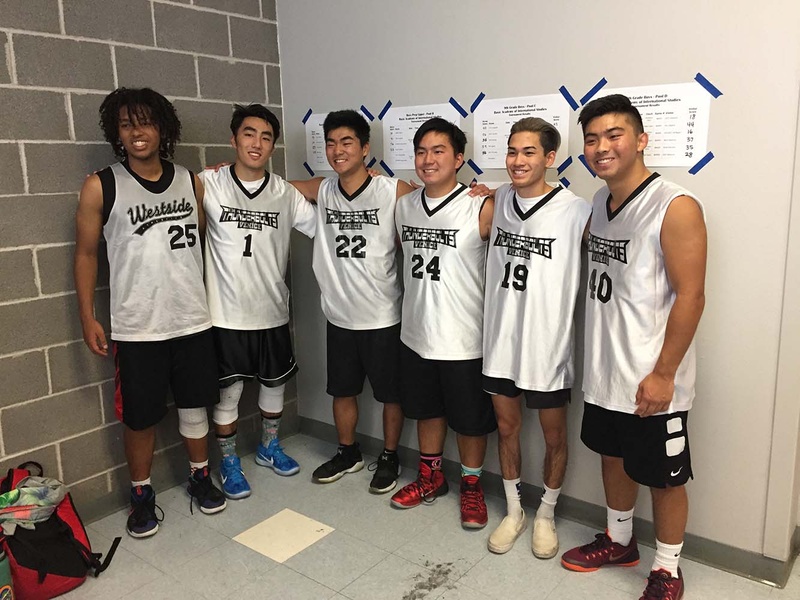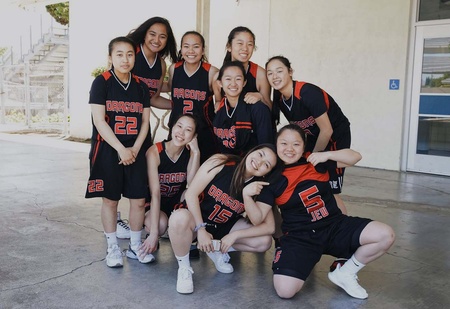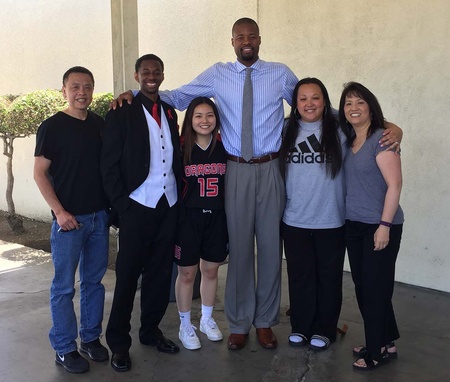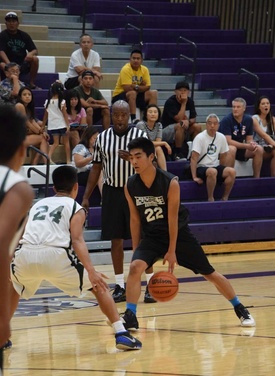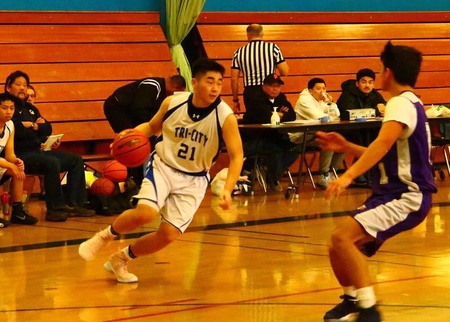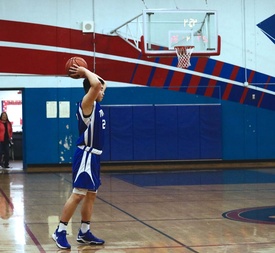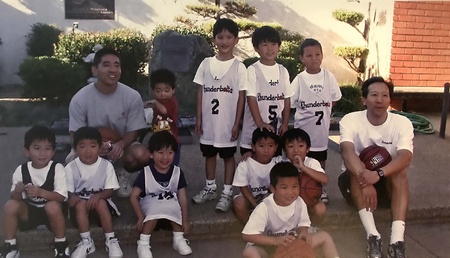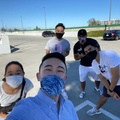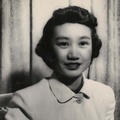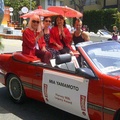For many, the Japanese American basketball leagues are a foundational part of their Japanese American childhoods. It’s a way for Japanese Americans from kindergarten to high school to play basketball and be involved in the Japanese American community. In California, these leagues are organized into two areas. The first area is in Northern California, which includes cities such as San Francisco and Sacramento, and the second area is in Southern California which includes Los Angeles and the San Fernando Valley. This article will compare the experience of Rossten Nakamura and Katelyn Kung, two players in the Northern California league, to Reese Komesu and Matthew Saito (myself), who play in the Southern California league.
The Japanese American basketball leagues have a rich history and a unique origin. During World War II, sports such as baseball and basketball were an integral part of the experience in the concentration camps. After Japanese Americans were allowed to leave the camps, they wanted to continue playing sports. However, it was hard to find any league to play in. Not many recreation centers, clubs, or other organizations would allow Japanese Americans to join their leagues due to lingering resentment towards them after the war, so Japanese Americans had to start a league of their own. Thus, the Nisei Athletic Union was formed in Northern California, the only league where Japanese Americans were allowed to play.
Through the Nisei Athletic Union, many Japanese Americans connected with one another, and slowly the league grew. As the league began to expand, many teams all over Northern California were created, and the Southern California league was formed.
In 2020, Japanese American basketball leagues still exist. In addition, the league also has adult teams. Most of the basketball teams are connected to Japanese American community centers, Buddhist temples, and Christian churches, so players also get a connection to their community by being a part of their basketball teams. Both the Northern California and the Southern California leagues are so large that they have separate divisions based on geographic regions. Furthermore, the leagues have now expanded and not only include Japanese American athletes, but other athletes of Asian American descent So now, more often than not, the Japanese American basketball leagues are known as the Asian American basketball leagues, although their roots are still in the Japanese American experience. The players that I interviewed have had first-hand experience in the leagues.
Katelyn Kung was the first player I interviewed. Katelyn is from San Francisco, California, and began playing in the 3rd grade. She played for the Bay Area Asian Sports Dragons, and played all the way up until she was a senior in high school. One of the unique parts of Katelyn’s experience was the fact that she travelled with her team to play in tournaments all over Northern California. Every year, she played in tournaments located in Reno and Sacramento, but even went to Los Angeles occasionally for tournaments. Some of Katelyn’s fondest memories included getting food after games with her teammates and going to Blackbeard's after tournaments.
However, Katelyn felt that she gained so much more experience than just traveling and socializing. Katelyn’s team’s mantra was the idea that family goes beyond blood. Katelyn’s team emphasized the fact that family is the bond that is shared between people, and DNA isn’t what ties a family together. This mantra allowed her to feel that she had meaningful relationships with her teammates that would go beyond just playing basketball.
In turn, she also felt that by being around her teammates, she was able to connect and be a part of the Japanese American community. Katelyn felt so comfortable with the community that she even mentioned that being involved in the Asian league made her believe that Asians were never a minority population, but a majority. It wasn’t until she got older that she realized that Asians were a minority group of people, although that never changed her perspective on the importance of the cultural significance of the league. From a young age, her mother always instilled in her the cultural importance of the league, and knowing this significance, she always appreciated what the league stood for and its impact on the community.
The next player I interviewed was Reese Komesu. Reese is from Westchester, California and began playing in the Southern California Asian league in kindergarten and continued all the way until he was a senior in high school. Reese played for the Venice Thunderbolts and was also on the Yonsei basketball team while in middle school. One of Reese’s major takeaways from the Asian league was that he was able to connect with his Japanese culture, a connection that he felt he wasn’t able to get from his school.
Reese attended Venice High School, where there aren’t many Japanese Americans. Reese mentioned that his high school friend group was very diverse. Reese loved the diversity of his group of friends, but he also enjoyed the fact that he had access to the Japanese American community through basketball. Reese felt that being a part of the community helped him connect with his Japanese American identity.
During his time playing, he also was able to play with Yonsei, a basketball program that allowed him to visit Japan and meet other basketball players who play in leagues that are similar to the Asian league in the United States. Through these teams, he got involved in the community through service projects such as the “Not Your Average Basketball Camp,” where he worked with students who had disabilities, and other service opportunities such as working in the fields at Tanaka Farms. Overall, the league had a positive impact on him, and in the future, he hopes to have his children be a part of the community as well, because it played such a huge part in shaping his upbringing.
The third player I interviewed was Rossten Nakamura. Rossten is from Mountain View, California. He started playing in the Asian league in first grade and continued until he was a senior in high school. Rossten played with the Tri City Youth Group, but he never played on one specific team because the organization rearranged teams every year to balance the competition. Rossten’s team was affiliated with the Mountain View Buddhist Temple, which connected him with the Japanese American community. Rossten helped set up for Obons, worked at the teriyaki chicken fundraisers, and attended fun events like mochitsuki. Through the events, he felt that he was able to connect with his culture and build strong relationships with his teammates.
Rossten emphasized the fact that Asian league was a foundational part of his childhood and that he enjoyed the small things such as getting food with his teammates, going to socials to meet other players, and the competition. However, Rossten mentioned that there were some obstacles that he had to overcome.
One of the main obstacles that he faced was getting cut from the San Jose Zebras. As a sixth grader, Rossten tried out to be on the San Jose Zebras, a highly sought-after club basketball team that was affiliated with the Asian league that also participated in the Amateur Athletic Union (AAU), which is club basketball. When Rossten got cut from the team, he was upset, but later used that as motivation to get better, and gained even more determination in life to never quit on his goals.
Eventually, Rossten was even able to play on other AAU teams, which broadened his perspective because his team was culturally diverse. Rossten felt that his experience playing on a club team that was not affiliated with the Asian league helped him connect with players who were not Asian American, so he felt that his basketball experience was a good balance of Japanese American community and connections to other cultural groups. Overall, Rossten mentioned that these experiences made him very grateful for the community. He was able to see all of the hard work that his past predecessors did, in order for him to be where he is today.
Finally, I’ll speak from my own experience in the Asian league. I began playing in the league when I was in kindergarten and continued until I was a senior in high school. I played on the Venice Thunderbolts as well, and Reese Komesu was one of my teammates. When I first started, I felt that the league didn’t really help connect me with my Japanese American identity, and it wasn’t until late in high school when I felt a bond. Growing up, I wasn’t very involved with the Japanese American community, so naturally, I wasn’t connected with my Japanese American identity. Looking back at my experience, being in the Asian league was one of the only ways that I was actually involved in the Japanese American community.
As I got older, I started connecting the dots, and at the end of my time in Asian league, I felt that through all of the community service, events, and games, I was able to understand the historical significance of the league and had a deep appreciation for it. But the appreciation was not the only thing that I took way from the league.
By playing on the same team since kindergarten, I was able to make meaningful friendships with some of my teammates. Even though my team had players who came and went, the ones who stayed became some of my lifelong friends—Reese, whom I interviewed, being one of them. These relationships are something that I’m so grateful for, and having teams stay together like they do in the Southern California league was a unique experience for me and something I’ll always remember.
After interviewing these players, I was able to gain a new understanding of the Asian basketball league. I realized that just by being a part of the league, I already had a connection with the people I had interviewed. All of the people I interviewed are friends that I’ve made because we had the shared connection of being in Asian league. Regardless of what city we were from, we were able to relate on a personal level about our experiences, which is something very unique in an organization.
After hearing their experiences, I believe that the league has developed very well, and even has more room to grow. In the future, I hope the league connects more players with other teams in the community. I believe that would allow players to come together in solidarity with our culture, and exemplify that the league is so much more than basketball. All the players that I interviewed, including myself, wished that we could’ve met more players from the different teams and that in and of itself would’ve increased solidarity.
In addition, I also hope that the league will emphasize the significance of Japanese American culture more directly. Again, all of the players, including myself, felt that they learned about Japanese American culture through people in the community, not through the league itself. Furthermore, they felt that many players didn’t know the cultural significance of the league because there were no historical explanations at their events and games. It is also hard to find this balance in terms of basketball and culture and to incorporate these aspects together, but many players felt that these are steps that the league could take in order to increase their impact, beyond what they already do.
In conclusion, the league plays such a big part in many player’s lives, and for some of the players, they felt that they had some of their fondest memories in Asian league. It connects players to their culture and allows them to get involved in their community and stay involved in the future. As time goes on, the league will continue to evolve. I am looking forward to seeing what it will become in the future.
© 2020 Matthew Saito


